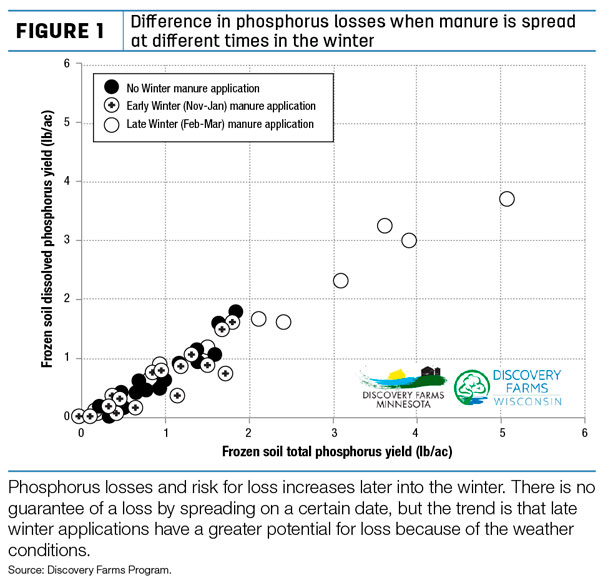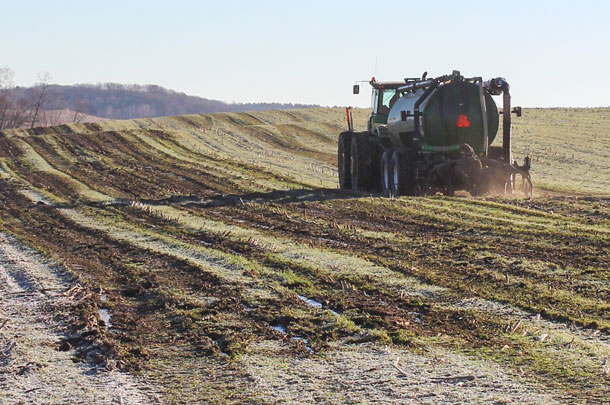In Wisconsin and Minnesota, the Discovery Farms Program has been turning privately owned farms into research stations for the past 15 years. The water quality data collected from participating farms is used widely in educational materials and presentations to farmers and farm advisers that are working to reduce losses of on-farm sources of nitrogen, phosphorus and sediment.
Winter manure application and wintertime losses of nitrogen and phosphorus are two topics that are often discussed among farmers, agency personnel and scientists.
Runoff from snowmelt and spring storms dictate annual runoff loss on Wisconsin farms. The months of February through June make up 92 percent of annual runoff totals on average. Runoff in February and March is caused by melting snow or rain while the soil is frozen, while runoff in April, May and June is usually caused by rainfall on already saturated soil. During the winter, the amount of runoff that leaves the field is mostly dependent on weather factors. Things like depth of snow, how it melts, how frozen the soil is and whether there is rain all determine the amount of runoff during the winter, and especially in March. Land management practices do not play much of a role in the volume of runoff during this time period.
While you may not be able to control the volume of runoff that leaves the field in March, you can control some factors about what is in it. There are two main management considerations for decreasing the amount of dissolved phosphorus loss from your fields.

1. Avoid manure application shortly before snowmelt or runoff. The soil and snow conditions of late winter are more risky for nutrient loss than early winter because of warming temperatures, increasingly intense solar radiation, rain on frozen and snow-covered ground, and frost- or ice-crusted soils. Discovery Farms data show that late winter manure applications lead to phosphorus losses two to four times higher than early winter or no winter manure application.
2. Consider placement of phosphorus (surface application or incorporation). Using no-till or limited tillage does a great job of eliminating soil loss, but continuous surface application of phosphorus can lead to dissolved phosphorus runoff, especially during the winter. It is a real challenge to get good placement of nutrients without doing too much disturbance and causing soil loss. Placement of phosphorus is a subtle adjustment that needs more attention, but not at the expense of soil conservation.
What can you do?
Manure application timing
The Runoff Risk Advisory Forecast can be a great tool for your toolbox to make decisions about when to spread. This online mapping tool started in Wisconsin and has spread to several other states. It is operated by the National Oceanic and Atmospheric Administration and the National Weather Service in cooperation with agencies and scientists with the goal of helping farmers to assess the risk for nutrient loss at the present time while taking weather conditions into account. Using this as a tool and using your own knowledge of local weather conditions is a great start.
Another important part of your risk management plan is to create a winter spreading plan with your farm or conservation adviser. Outline areas that are far away from surface waters, are flat and have little snow so that manure can contact the soil surface. Having a plan in place before winter allows you to be prepared for any situation and minimize risk as much as possible.
The riskiest time period of the year for runoff is March. Runoff in March is twice as high as in June, the next closest month. Discovery Farms data show that dissolved phosphorus loss is also two times higher in March than in any other month. On one monitored farm, the farmer was able to reduce phosphorus loss from nearly 4 pounds per acre to 1 pound per acre annually just through closely watching weather conditions and finding ways to avoid spreading right before runoff. If you must spread manure every month of the year, work with your conservation resource professional to identify fields that are at a lower risk for surface runoff or groundwater impact.

Placement
While you are considering equipment that allows better placement without causing too much soil disturbance, do some incremental soil testing. Traditional soil tests that are used for fertility recommendations go down 6 inches. To reduce risk of dissolved phosphorus loss in no-till systems that utilize surface application of phosphorus, take soil samples of the top 2 inches and work to keep phosphorus levels in the top 2 inches below 75 ppm. Discovery Farms data show that once the surface phosphorus levels increase above 75 ppm, the risk for dissolved phosphorus loss in the winter increases.
Winter in the Upper Midwest is unavoidable and makes manure management difficult. It plays a large role in annual phosphorus losses. With subtle tweaks to your farming system and decision-making process, you can minimize your risk of loss, even in the harshest conditions. ![]()
Amber Radatz is co-director of UW Discovery Farms.
PHOTO 1: Based on on-farm research, early winter manure applications are less likely to lead to phosphorus loss compared with manure applied in February and March, which is at greater risk of runoff.
PHOTO 2: Low disturbance manure incorporation in November limits phosphorus loss. Photos provided by Amber Radatz.





